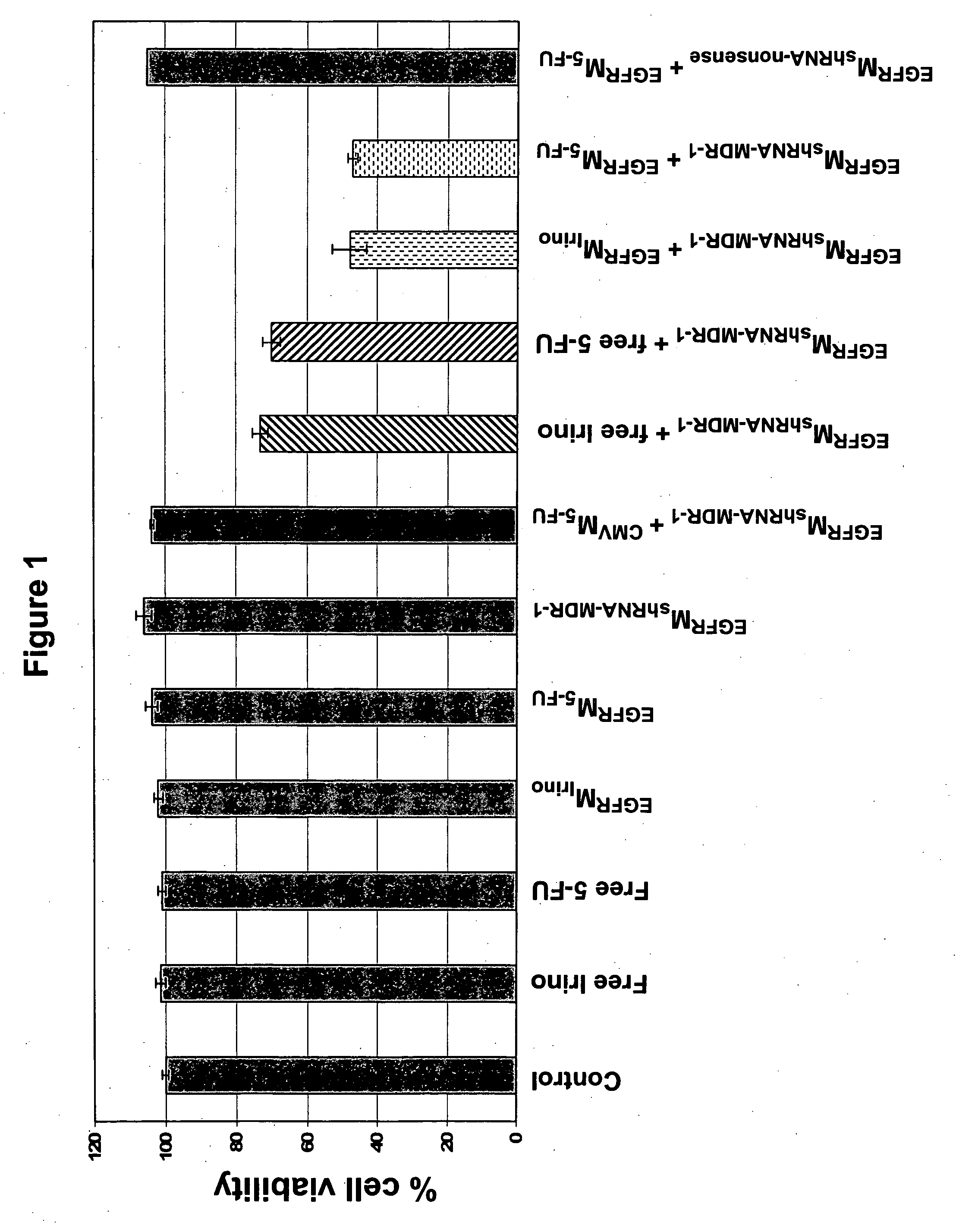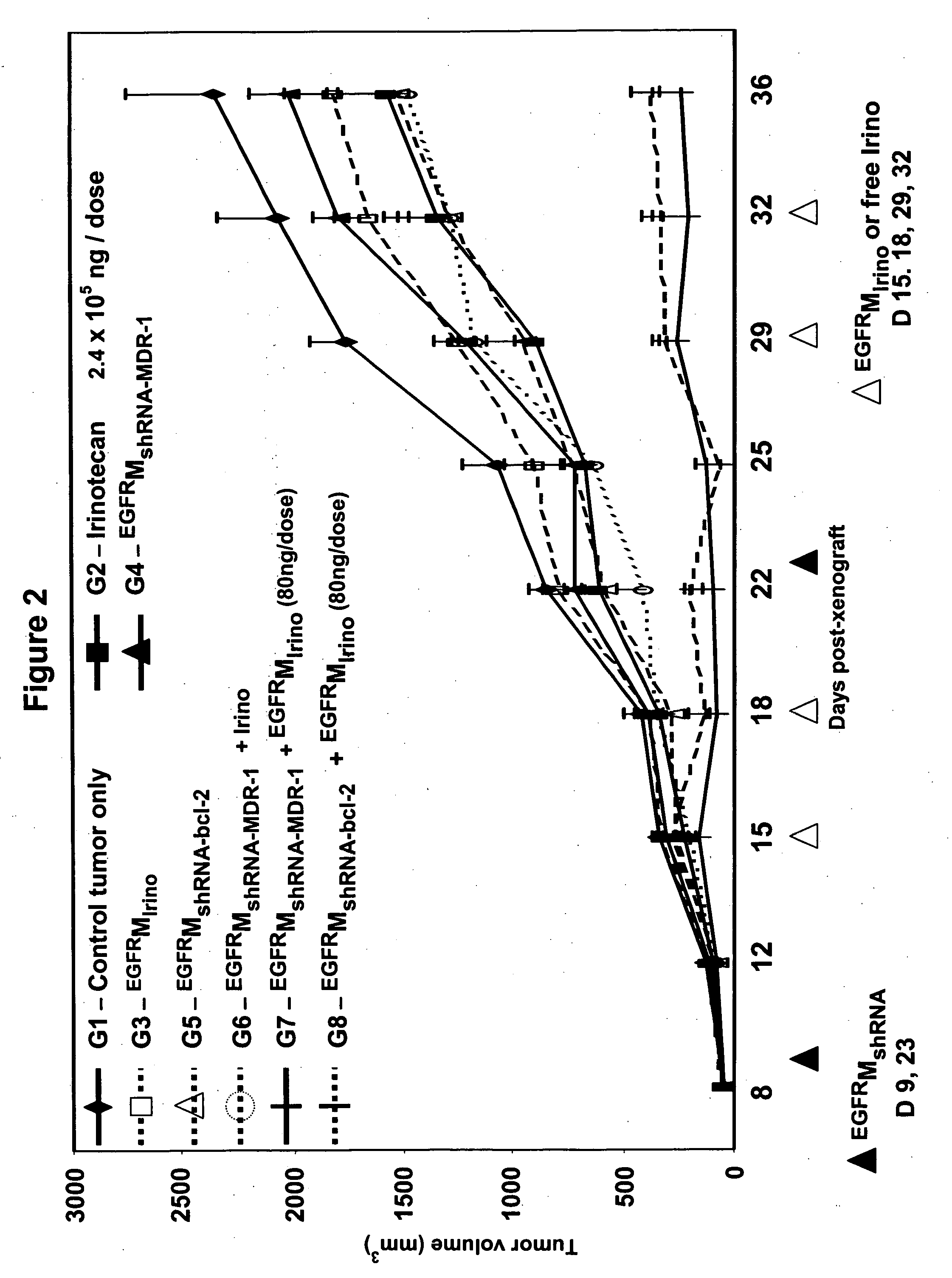Delivering functional nucleic acids to mammalian cells via bacterially-derived, intact minicells
- Summary
- Abstract
- Description
- Claims
- Application Information
AI Technical Summary
Benefits of technology
Problems solved by technology
Method used
Image
Examples
example 1
Anti-MDR1 and anti-bcl-2 shRNA Expression Plasmids and Purification of Recombinant Minicells
[0192] Recombinant minicells carrying plasmids encoding shRNA sequences (Mdr1 or bcl-2) were generated as follows. The Mdr1 shRNA sequence used in this study was described by Wu et al., 2003 (5′-TCGA AAGAAACCAACTGTCAGTGTA gagtactg TACACTGACAGTTGGTTTCTT TTTTT-3′) (SEQ ID NO: 1) and the bcl-2 shRNA sequence used was described by Wacheck et al., 2003 (5′-TCGATGTGGATGACTGAGTACCTGA gagtactg TCAGGTACTCAGTCATCCACATTTTT-3′) (SEQ ID NO: 2). The respective shRNA sequences were synthesized and individually subcloned into plasmid IMG-800 (Imgenex Corp., San Diego, Calif., USA) such that the sequences could be expressed from the plasmid U6 promoter. The plasmid carries the pUC origin of replication which enables high plasmid copy numbers in bacterial cells. The recombinant plasmids were sequenced to ensure that the shRNA sequences were correct and in-frame for expression from the U6 promoter. The recombi...
example 2
Demonstration of Receptor-Targeted Recombinant Minicell-Mediated shRNA Plasmid Delivery to Drug Resistant Cancer Cells and Reversal of Drug Resistance In-Vitro
[0193] While siRNAs directed against a range of different drug-resistance encoding transcripts have been shown to reverse drug resistance in cancer cells in-vitro, the critical hurdle is targeted delivery of the siRNAs into cancer cells, particularly in-vivo. Recombinant minicells carrying anti-MDR1 shRNA plasmid (minicellsshRNA-MDR1) and control shRNA against a nonsense RNA sequence (minicellsshRNA-nonsense) were purified and bispecific antibody carrying anti-S. typhimurium O-antigen and anti-human EGFR specificities was prepared and attached to the recombinant minicells, as described in patent application Wo 2005 / 056749. The targeted recombinant minicells were designated EGFRminicellsshRNA-MDR1 and EGFRminicellsshRNA-nonsense. Minicells packaged with chemotherapeutic drugs 5-FU and irinotecan were also prepared and targeted...
example 3
In-Vivo Demonstration of Tumor Regression Achieved Using the Method of Invention i.e. Dual Treatment of Receptor-Targeted Minicell-Mediated shRNA Delivery Followed by Receptor-Targeted Minicell-Mediated Drug Delivery
[0200] This example demonstrates that receptor-targeted minicells can be used to reverse drug resistance in cancer cells in-vivo.
[0201]S. typhimurium minCDE-derived minicells were purified and packaged with chemotherapeutic drug irinotecan. 7×109 minicells in BSG solution were centrifuged, the supernatant was discarded and the minicells were resuspended in 940 μl BSG and 60 μl of irinotecan solution (1 mg / ml; dissolved in sterile distilled water). The suspension was incubated overnight at 37° C. with rotation to allow the irinotecan to diffuse into the minicell cytoplasm. Excess irinotecan non-specifically attached to the outer surface of the minicells was then washed away by stirred cell ultrafiltration as follows. Amicon stirred ultrafiltration cell Model 8010 (Milli...
PUM
| Property | Measurement | Unit |
|---|---|---|
| Electrical resistance | aaaaa | aaaaa |
| Surface | aaaaa | aaaaa |
| Surface structure | aaaaa | aaaaa |
Abstract
Description
Claims
Application Information
 Login to View More
Login to View More - R&D
- Intellectual Property
- Life Sciences
- Materials
- Tech Scout
- Unparalleled Data Quality
- Higher Quality Content
- 60% Fewer Hallucinations
Browse by: Latest US Patents, China's latest patents, Technical Efficacy Thesaurus, Application Domain, Technology Topic, Popular Technical Reports.
© 2025 PatSnap. All rights reserved.Legal|Privacy policy|Modern Slavery Act Transparency Statement|Sitemap|About US| Contact US: help@patsnap.com



